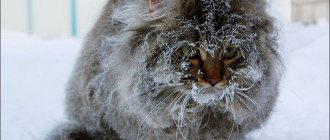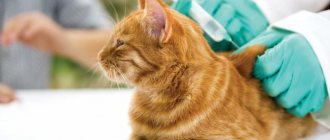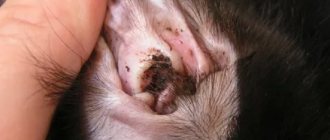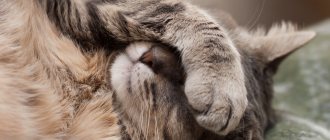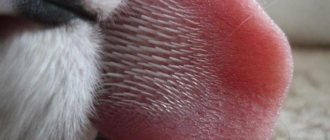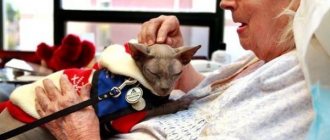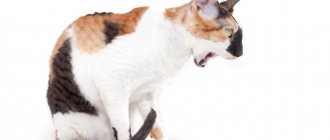Cats and claws
In this article, I will explain why cats change the sheath of their claws, why this happens, and how to help keep your cat's claws healthy and strong.
Read on to find out more. Cats grow fur all year round and twice a year, as the seasons change, they go through a major shedding process to ensure they have the appropriate coat for the upcoming warmer or cooler weather. Cats also change their whiskers and eyebrows, and sometimes the sheaths of their claws.
Since its sheath is very similar to a full cat's claw, for a new cat owner to find a cat's claw sheath for the first time at home may seem like a strange and alarming sign, but changing claw sheaths is a normal process for any domestic cat and is not a sign of illness.
What is a claw sheath?
Your cat's claws are made of tough, keratin protein that is very strong and durable. The claws are so strong in order to support the weight of the cat while climbing trees, curtains and other vertical objects in their environment. However, unlike dog nails, which continue to grow unless they are trimmed or worn down by walking on hard, rough surfaces, cat nails grow to a certain point of self-limitation, after which they stop growing in length.
While dogs may have problems with overgrowth of nails curling inward and growing into the pads of their toes, cats' nails will not continue to grow and grow unless the growth is artificially stopped.
The sheath is the outer layer of the claw itself, and claws have a layered structure and grow in layers, starting with the newest growth in the center and the oldest layers of growth on the outside.
Why do cats shed the sheaths of their claws?
To remain functional, a cat's claws must be strong, sharp and
practical, meaning that when the sheath of the claw begins to stretch a little at the tip, your cat will shed it off the claw to reveal a new, strong and sharp claw. A domestic cat's skin renews itself on a cyclical basis every three months - meaning that every three months or so, your cat will replace all of its previous claws with new ones.
Scratches and healthy claws
Cats need to scratch things to keep their claws sharp and short enough to be practical, and this process helps remove old layers of claws. To help your cat change its claws, install a scratching post or sisal post in your home!
Scratching things also allows your cat to exercise the muscles in her hands and feet by extending and retracting her claws, keeping them in good condition and allowing your cat to grasp, lift, catch and hold prey.
Provide your cat with a scratching post or a place to scratch, otherwise she will almost certainly find an alternative on her own, such as the living room rug, the legs of your sofa, and the like.
If your cat's claws grow too slowly for the animal to shed the claw sheaths on its own, you may need to trim the very tips of the claws, being careful not to damage the blood- and nerve-rich living tissue in the claws, which will bleed profusely if damaged. Also, an acute injury will cause pain and be a nuisance for your cat.
What products are used to strengthen claws?
A popular vitamin complex is Brevers CALCIDEE 8 in 1. Its main advantage is that it contains only the most important vitamins for the pet’s body and
substances in the required balanced amount (vitamin D, calcium, phosphorus). Thanks to this, the vitamin complex can be taken with any food.
As an alternative, you can consider Beaphar Kitty's Mix multivitamin complex, it contains much higher amounts of minerals and vitamins, and also contains at least 4% cod. However, you should be careful when “prescribing” multivitamin complexes to your pet, because they contain many different vitamin groups, an excess of which in the pet’s body will not lead to anything good.
Additionally, you can saturate your cat’s body with essential microelements and vitamins using oat sprouts. They can be purchased at any veterinary pharmacy or grown yourself. Sprouts must be added to the animal’s food at least once a week.
It is also recommended to introduce fresh, unheat-treated cod liver, fresh fish, meat and boiled vegetables into the cat’s diet. With an integrated approach, you can get rid of the problem in a matter of weeks.
Caring for a cat is a process that often plunges pet owners into panic. One of the alarming manifestations that one has to deal with is that a cat’s claws are peeling, and often there are no obvious reasons that cause an alarming sign. In order to properly eliminate the symptom or prevent its occurrence, it is recommended to understand in advance the main factors that provoke the problem.
Does a cat change its claws?
Soon after we got a kitten at home, I heard my eldest daughter’s alarmed cries: “Daddy! Our Petya seems to have lost his claws! Several "claws" were found lying quietly on the living room carpet. I had to give the child a short lecture - cats not only shed twice a year! Not only do they grow a new mustache! About once every three months, the outer shell of their claw peels off. It looks like the cat has really lost it! But upon external examination it is clearly visible - everything is in perfect order, all the claws are in their place. It's OK!
How does a cat's claw work? The claw is made primarily of keratin, a tough and incredibly strong protein that forms a sheath around the living soft part containing blood vessels and nerves. Claws are vital for a cat. Notice how, in moments of danger, the animal uses its claws to climb to the top of the tree. The claws are so strong that they easily hold the weight of their “owner”.
Unlike dogs, cat nail length is usually “self-regulating”—meaning no additional input is required on your part (with a few exceptions, of course). The claw grows in layers - “new” layers are born in the core, and old ones gradually appear “from the very edge”. The “oldest” layer is called the shell, which peels off over time.
Why is this happening? As you and I already know, it is vital for a cat to keep its claws in perfect order - sharp, of optimal length. A cat knows how to take care of the health of its claws itself - it regularly “sharpenes” them (that is, checks the “workability” of the topmost layer). In everyday life, we observe how a cat, using an object that catches its eye, begins to scratch and scrape along it with its claws (“sharpening its claws”). At one point, the upper shell peels off, making room for a new, stronger and healthier one. This happens about once every three months! Of course, we hope that you have chosen the “right” scratching post for your furry pet and are saved from numerous problems!
Some general tips and recommendations. Now you, dear readers, know what exactly we mean by the phrase “sharpen your claws.” Among other things, by “exercising” on the scratching post, the cat does exercises and keeps the paw muscles toned!
What to do
There are several ways to solve the problem of claw separation:
- Scratching post. This unit will help the cat to independently get rid of the exfoliated shell of the claws by pointing them. The claw grinder can come in various shapes and sizes. They can be mounted on a wall, the back of a sofa, or any other place that the cat chooses for a claw point.
- Trimming nails. This procedure should be carried out very carefully so as not to damage the claws or cause bleeding and even greater separation. For the first time, it is better to contact a veterinarian who will trim the ends correctly and teach you how to do it yourself.
Tip: When trimming your pet’s nails yourself, you need to be careful and trim only the very tip. If you cut off more than necessary, you can touch the cat’s nerve endings and hurt her. In some cases, this can even lead to bleeding and inflammation.
- Claw attachments. If your cat's claws are peeling off, try purchasing these attachments. They are made of soft silicone and serve to protect both the cat's claws and furniture and other objects that can be used for the point. They do not cause discomfort to the pet and protect its owners and interior items from scratches.
You can choose any color from the anti-scratch pads
But with an existing scratching post and regular trimming, you will still notice a clearly even separation of the claws. You may just need to feed your cat a balanced diet and give her extra vitamins for healthy nails. Only then will you and your pet forget about unnecessary stratification.
To completely forget about the problem of peeling claws in a cat and the negative consequences of this problem, pay attention to Anti-scratch. These products are made of soft silicone and are absolutely safe for your pet. They simply attach to the claws and prevent the cat from scratching everything he sees in his path, be it furniture or a small child. This product has many color options, which will allow you to choose it exactly to match the color of your pet.
Claw growth: Why cats sharpen their claws
When retracting the claws, which have a scaly shell, the cat feels discomfort. That is why she begins to sharpen her claws on various surfaces in order to remove the exfoliated membrane from her nails. In natural conditions, trees that cats like to climb are used for this purpose, and in domestic conditions - any available objects, including furniture. To prevent this, you need to purchase a special scratching post or tips for claws.
There is another reason why cats sharpen their claws. On their paws there are special glands from which a secret is released that is inaccessible to the human sense of smell, but accessible to other cats. During the period, cats mark their territory, especially if there are several of them in the house.
Factors that provoke claw separation
One of the reasons for nail separation in pets is the natural growth of a new stratum corneum. This happens especially often in animals that are rarely outdoors and do not have the opportunity to grind their nails on asphalt or trees. A cat’s nails usually peel off once every few months; the owners’ help is not needed to remove the stratum corneum - the pet will deal with the problem on its own, removing unnecessary tissue with its teeth. Another reason for the appearance of delamination on the claws is mistakes made by the owners when cutting keratinized tissue. Excessive or insufficient shortening threatens the growth of a new layer, which after some time will begin to peel off. Improper trimming of keratinized tissue not only provokes disturbances in the growth of claws, but can also cause serious injury.
The last cause of the problem is an incorrectly formulated diet. A lack of minerals and vitamins leads to disturbances in metabolic processes in the body of a pet, which culminate in cracking of the stratum corneum. Addiction to store-bought food and the lack of natural products in a pet’s daily menu are the main causes of problems with cat’s nails.
Why do they release claws?
It often happens that the cat marks time or lies on its knees and releases its claws at this time. Why a cat releases its claws is very important to know. After all, many owners begin to trim their cat’s claws and scold her when she puts out her claws at the wrong moment, but this is not recommended.
In fact, the phenomenon when a cat moves its paws and this is accompanied by the release of its claws is called a “milk step”. This comes from childhood, when kittens, when feeding on mother's milk, press on the mother's mammary glands with similar movements. Usually a milk step is a sign of affection from a cat, so you should never scold it. If these movements cause you discomfort, simply purchase soft silicone claw attachments.
Lack of vitamins in the pet's body
The animal body, like the human body, reacts sharply to a lack of vitamins. The absence of certain vitamin groups and microelements in a pet’s body can provoke delamination of its claws.
Vitamin deficiency in animals often occurs against the background of a disordered, unbalanced diet. If, for example, a cat eats alternately different types of food and partly “homemade food”, then in this case it may have a deficiency of certain vitamins in the body.
For some cats, owners fundamentally do not give certain foods, such as fish and meat, because the animal has a negative reaction to them. The systematic absence of certain foods in a cat’s diet can lead to vitamin deficiency.
Main causes of delamination
Three reasons why a cat's claws completely peel off.
- Growth of claws. Most often, a cat's claws peel off due to their growth, which is accompanied by renewal of the stratum corneum and placement of the claw in a special scaly sheath. It comes off over time and causes separation. At home, you should use a scratching post.
- Incorrect care. When a cat's claws peel off after a haircut. Detachment can begin due to improper care of the claws, namely due to sloppy trimming, which can greatly injure the claws. We wrote in more detail about how to trim a cat’s claws.
- Lack of vitamins. If there is a lack of essential nutrients that can enter the cat's body with food, claw separation may begin.
The first two reasons are absolutely natural. Particular attention should be paid to the third point.
The cat's claws match the color of the outfit
Proper nutrition – what to include in your pet’s diet
If your cat's nails are split, immediately review your pet's daily menu. You should not delude yourself and believe beautiful advertisements - even the most balanced food will not replace ordinary meat, vegetables, fish, and dairy products. A pet's diet should consist of the following products:
- fresh meat;
- boiled vegetables;
- fish (fresh river fish is not recommended; it is better to boil it first, otherwise there is a risk of infecting the animal with worms);
- porridge;
- soups (remove fat first);
- dairy products (do not give milk in its pure form, the cat may develop diarrhea).
It would be a good idea to introduce vitamin complexes into the diet, especially if owners prefer to pamper their pet with store-bought food. It is better to find out from your veterinarian which vitamins are responsible for the good condition of the nail plates. You can replace vitamins with cereals, which contain all the elements necessary for a pet. Most often, oats are used, which are recommended to be pre-sprouted. You need to add chopped greens to your main feed at least once a week. For an adult cat, the dosage of green gruel is at least 15 g.
Be sure to include cod liver in your cat’s diet, which contains substances necessary for good growth and to prevent cracking of nail tissue. Do not heat treat the product; during cooking, some of the beneficial elements disappear.
Usually, regular nail trimming, proper diet and frequent walks, which allow the cat to wear off dead tissue, are enough to forget about the problem for a long time. If this does not happen, the nail plates continue to separate, and you will have to give up trying to help your pet on your own and go to the veterinarian.
Cats make wonderful pets. But in vain many people think that there are no problems with them. This is wrong. For example, cat owners may often notice that their pet’s claws are peeling. What could this be connected with, and what to do in this case?


